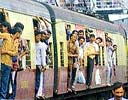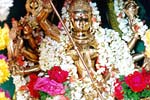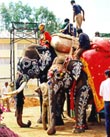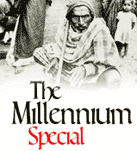The Rediff columnist lists ten reasons why he lives in India.
It made sense, the idea of this list, because what's on it answers the question I get asked most frequently: "Why did you come back to India?" After all, I lived -- studied, worked -- in the USA ten years. In the
nearly 8 that I've been back, I reckon I've been asked the question several
hundred times.
 I'm certain I want to live in India. But that certainty has always been a
feeling in the gut, rather than one prompted by a list of particular
attractions felt and chased. So this exercise forced me to examine that
feeling in the gut and tease out the reasons I'm here. Some overlap others
in ways, some are Bombay-specific (though applicable in different forms
elsewhere in India, I'm sure), some may seem meaningless to many. But they
are mine. They add up indisputably, unerringly, to why I live in India.
I'm certain I want to live in India. But that certainty has always been a
feeling in the gut, rather than one prompted by a list of particular
attractions felt and chased. So this exercise forced me to examine that
feeling in the gut and tease out the reasons I'm here. Some overlap others
in ways, some are Bombay-specific (though applicable in different forms
elsewhere in India, I'm sure), some may seem meaningless to many. But they
are mine. They add up indisputably, unerringly, to why I live in India.
So with no more ado, here are those reasons. I nurse the hope they will
strike chords in you.
10. COLOUR

Suburban train, crammed with commuters. Dull grey, brown, darker brown
flashes by; then, all of a sudden, patches of brilliant greens, reds,
yellows, blues. The women's compartment.
 The colours of India. Women's saris. Mounds of coloured powders as Holi
approaches. Yellow bananas, green-yellow oranges, pale pink apples, bright
green chillies, gleaming yellow limes, all at your streetside fruit and
veggie vendor. Heaps of shiny glass bangles. Even the often horribly
mismatched colours on railings or gates in public places -- but to
Beelzebub with matching colours! Who wants them?
The colours of India. Women's saris. Mounds of coloured powders as Holi
approaches. Yellow bananas, green-yellow oranges, pale pink apples, bright
green chillies, gleaming yellow limes, all at your streetside fruit and
veggie vendor. Heaps of shiny glass bangles. Even the often horribly
mismatched colours on railings or gates in public places -- but to
Beelzebub with matching colours! Who wants them?
9. ROOP TERA MASTANA
 The song from Aradhana. Curiously, I've never seen the film, but I've always thought this is one of the finest songs ever written anywhere (right
up there with I Believe I'm In Love by the Fabulous Thunderbirds and Barefoot Rock by the Blasters).
The song from Aradhana. Curiously, I've never seen the film, but I've always thought this is one of the finest songs ever written anywhere (right
up there with I Believe I'm In Love by the Fabulous Thunderbirds and Barefoot Rock by the Blasters).
It's a terrific piece of music. Still, I don't mean just this song by
itself, but the whole Indian film music scene of two or three decades ago.
I never could keep straight who wrote or sang what, and in which film, but
there was a steady stream of magnificent songs in those days. RTM, in Kishore Kumar's husky whisper, led the way.
Like old-timers always do, I marvel in wonder at the strange sounds that
pass as film music these days. What can I say, except: "Aaj nashe mein,
sara jahan hai!"
8. AN ELEPHANT AND TWO GEESE
 Not just any elephant and two geese. One morning at the office in Bombay's
Fort district, twiddling my thumbs as usual, I looked out my window and up
the always impossibly crowded lane that leads away from our street. It was
crowded this morning as well. But strolling amiably along it, stopping to
greet the occasional shopkeeper, was: an elephant.
Not just any elephant and two geese. One morning at the office in Bombay's
Fort district, twiddling my thumbs as usual, I looked out my window and up
the always impossibly crowded lane that leads away from our street. It was
crowded this morning as well. But strolling amiably along it, stopping to
greet the occasional shopkeeper, was: an elephant.
Another morning, a grey and rainy one this time, the same street was
utterly deserted. Except for, strolling long-necked-ly and nonchalantly
towards me: two geese. I find the two have taken up residence on the
pavement outside my building. In the heart of downtown Bombay.
Only in India.
7. THE LIFE IN PUBLIC TRANSPORT
Travelling home in a routinely packed train one evening, I had to make way
for two men who got in carrying various bulky objects. They struggled to
the centre of the compartment and unveiled: a mike, a small keyboard, an
amplifier and a speaker. One played, the other sang. A nice mix of familiar
songs and their own compositions. (Not RTM, unfortunately). The next day, a profile in the morning paper told me they were musicians from West Bengal, aspiring to the lights of Bollywood.
Where else in the world would two young men begin their hopeful trek to
fame in a second-class compartment during rush hour?
And it isn't just musicians. Public transport of any kind in India is
forever being worked by peddlers of everything: combs, agarbatti, fruit,
keychains, diaries, drinks, juices, pens.
Even dreams.
6. EVERYTHING IS RECYCLED, ESPECIALLY BOOKS
Other places have their second-hand book stores. Bombay does too, the
famous New and Second-Hand Bookstore at Dhobi Talao. But if you're a
compulsive reader on a budget, you don't have to go there to find used
books. On nearly every street in the city, in nearly every railway station,
some enterprising soul has laid out a cloth and a few, or many, books on
it. Always worth the halt to browse. That's how I picked up an excellent
copy of The Bell Curve Debate from a tiny boy on the Bandra station overbridge. Rs 50.
And it isn't just books. Paper of every description is recycled. Which is
why hope springs eternal in my breast about the diary I kept during my
3.5 month Africa trip. Lost it on the train 7 years ago. Left me morose for
months. Perhaps one day, I will come across pages from it used to wrap the
fruit I buy, or the channa I buy, or the eggs I buy. Well, I can hope,
can't I?
5. THAT LIFE IS NOT SO SANITIZED
Nothing comes simple in India. In contrast, the US often seemed somehow
over-sanitized. I mean, take the bus I travelled to Pune in once. As my
bones shook nearly to pieces, it occurred to me that this contraption would
never have been allowed to ply in the US. Yet here it was doing just that,
rattles and groans and loose floorboards and all. You know it will remain
on the road for years to come.
Certainly regulations and so forth are good. Certainly they work to promote
public safety. I'm all for them in greater measure in India.
Yet at the same time, it's these faltering things -- like rattletrap buses
-- that lend a certain edge to daily life in India, a certain vitality,
that the West seems to have lost. Call me perverse if you like, but I can't
explain better than that.
4. MUCH TO SEE
 Not one country offers the stupendous variety of fascinating places to
visit that India does. Mountains? Temples? Mosques? The desert? Rivers?
Beaches? Wildlife? Monuments? Throbbing city life? Double-decker buses? All
those and more, in India. In the best tradition of travel, the more you do
it in India, the more that's left to see.
Not one country offers the stupendous variety of fascinating places to
visit that India does. Mountains? Temples? Mosques? The desert? Rivers?
Beaches? Wildlife? Monuments? Throbbing city life? Double-decker buses? All
those and more, in India. In the best tradition of travel, the more you do
it in India, the more that's left to see.
 So on my list that grows all the time: Kutch. Calcutta. Ladakh. Sikkim. The
Northeast. Amarkantak. Jaisalmer. The Karnataka coast. MP. Bhuleshwar.
Dwarka. Pulicat and Chilika Lakes. Belur/Halebid. I could go on. And on.
One day I will.
So on my list that grows all the time: Kutch. Calcutta. Ladakh. Sikkim. The
Northeast. Amarkantak. Jaisalmer. The Karnataka coast. MP. Bhuleshwar.
Dwarka. Pulicat and Chilika Lakes. Belur/Halebid. I could go on. And on.
One day I will.
3. MUCH TO WRITE
By the mugful, stories drift about out there, waiting to be written. You
only have to step out to have them drape themselves all over you. What's
with the cobbler near Metro who has this sign up: "India ka High Hitler"?
Who is the poor man who walks my street every morning, shouting
unintelligibly, waving a long stick? What possesses a university professor
to play carrom by himself for 24 hours in search of a Guinness Book record?
Always something more to be learned in and about India, something more to
write about. And just for that little extra zip: in the learning and
writing, the always-present chance to make a difference, however small. The
chance to stimulate some thought, some discussion. The best reason of all
to write.
2. FAMILY
Enough said.
1. THE IDEA OF INDIA, apologies to Sunil Khilnani
Off the top of my head, Bombay has at least 28 daily newspapers in 5
different languages. (I know I haven't got all the papers in those 5
languages, and there are papers in several more languages as well). I don't
know one other city in the world where you'd find this kind of variety.
In an odd nutshell, that's India. This enormous experiment in modern
nationhood, that would mould it out of diversity unknown anywhere. This
gigantic effort to give innumerable disparate people common cause. After
all, what binds together me and the Manipuri?
 This experiment, this effort, this India -- it stutters and stumbles; by my
count its failures far outnumber its successes; it is crammed to the gills
with frustrating perversities; it is blessed with some of the world's most
venal people as leaders. And yet in spite of all that, because of all that,
it is endlessly fascinating, rich in life, a gold mine of opportunity and
experience and learning.
This experiment, this effort, this India -- it stutters and stumbles; by my
count its failures far outnumber its successes; it is crammed to the gills
with frustrating perversities; it is blessed with some of the world's most
venal people as leaders. And yet in spite of all that, because of all that,
it is endlessly fascinating, rich in life, a gold mine of opportunity and
experience and learning.
Eight years back in India and I know more firmly than ever: I would never
live anywhere else.
Tell us what you think of this list
